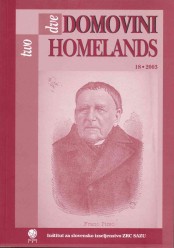ON MULTICULTURE AND ON SIGNIFICANCE OF HETEROGENEITY OF NATIONS, LANGUAGES AND CULTURES
Abstract
The author deals with the development of multicultural relations in Australia after World War II, which various racisms and the right wing anti multiculture activity opposed. The revival of Australian ethnocentrism obstructed the actual rise of multiculture, which the author noticed already in 1989 when leaving Australia. An increasing gulf was occurring between the principal declarativeness and the actual life in the spirit of multiculture. The author made parallels between the fate of black coloured population in the U.S.A. and the European integrational processes. On the one side, there is the rhetoric, and actual relations on the other side that are far from the principles of multiculturalism. He is pointing out the harmfulness of national and language discrimination, which leads to destruction of a nation or a national community, and consequently to dilapidation of morals and the system of values, and to self-destructive dispositions. The author considers preserving of nationality, culture and language the most important social tasks, in the fields of emigration and immigration as well. Preserving language and ethnic identity definitely is not some maintaining of obsolete social circumstances as some anthropological and sociological schools want to present; such preserving bases on the fact that every human carries in oneself genetic elements of one’s development.
Downloads
References
Adamič, L. (1970). O rel in korenine. Ljubljana: DZS.
Banchevska, R. (1982). Uprooting and setting: the transplanted family. V: L. Eitinger, D. Schwarz (ur.), Strangers in the world (str. 107-132). Hans Huber: Bern.
Blainey, G. (1984). AllforAtistralia. Sydney: Methuen Haynes.
Blainey, G. (31. 12. 1988). Australia 1988. The age ( Melbaurne), str. 23.
Encel, S. (1986). Ethnicity and multiculturalism. The Australian quarterly, 58 (3), 308¬ 325.
Forstnerič, F. (1983). O dprto pismo. Dialogi, 6, 62-65.
Georgiou, P. ( II . 1997). The authentic face o f Hansonism. The age (Melbaurne).
Hawthorne, L. (1. 10. 1988). The Asian experience. The age (M elbaume). Saturday extra, str. 1-2.
Hunt, E. F. (1966). Social science. New York: Macmillan.
Jung, K. G. (1969). Lavirint u čovekti. Beograd: Vuk Karadžić.
Klinar, P. (1983). M ednarodne migracije v kriznih razm erah. Dialogi, 6, 62-65.
Lewis, E. G. (1980). Bilingualism and bilingual ediicalion. Albuquerque: University of New Mexico Press.
Luria, A. R. ( 1973). The working brain. Harmondsworth: Penguin books.
M acD onald, J. (6. 5. 1999). H eat on PM over multiculturalism. The age (Melbourne).
Mead, M. (1966): Cultural change and character structure. V: M. Stein et al. (ur.), fden tityan dan xiely (str. 88-89). New York: Free Press.
Minas, I. H. et al. (1996). M ental heallh services for NESB immigrants. Canberra: Australian Government Publishing Service.
Minas, I. H., D. Silove, J. P. Kunst (1993). M ental heallh for multicultural Auslialia: o nalionalslrategy. Melbourne: The Victorian Transcultural Publishing Service.
Wilson, D. (19. II. 1988). Australia's death cells. Good weekend (Melbourne), str. 56-67.
Zalokar, J. (1991 ). Mavrična kača. Radovljica: Didakta.
Downloads
Published
How to Cite
Issue
Section
License

This work is licensed under a Creative Commons Attribution-NonCommercial-NoDerivatives 4.0 International License.
Authors guarantee that the work is their own original creation and does not infringe any statutory or common-law copyright or any proprietary right of any third party. In case of claims by third parties, authors commit their self to defend the interests of the publisher, and shall cover any potential costs.
More in: Submission chapter





